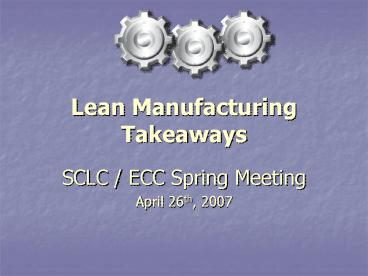Lean Manufacturing Takeaways - PowerPoint PPT Presentation
1 / 19
Title:
Lean Manufacturing Takeaways
Description:
Lean constitutes a philosophy / culture of how to satisfy customers' increasing ... Don't follow all recipes exactly as presented. Implementing Lean - Organization ... – PowerPoint PPT presentation
Number of Views:309
Avg rating:3.0/5.0
Title: Lean Manufacturing Takeaways
1
Lean Manufacturing Takeaways
- SCLC / ECC Spring Meeting
- April 26th, 2007
2
Remember what Lean is?
Lean constitutes a philosophy / culture of how to
satisfy customers increasing demands for greater
value. An ideal value-creation process exists
when the fewest number of steps are
properly sequenced and made to continually flow.
Waste Eliminated
3
Lean is a philosophy which shortens the time line
between the customer order and the shipment by
eliminating waste.
Business as Usual
Waste
PRODUCT SHIPMENT
CUSTOMER ORDER
Time
Lean Manufacturing
PRODUCT SHIPMENT
CUSTOMER ORDER
Time (Shorter)
4
Basic Lean tools you will need
5
Implementing Lean - Leadership
- An inspired leader at the top is required,
somebody who takes responsibility for change. - Operating managers need continual education and
assessment to assure no backsliding. - Change agent has to fully understand Lean
Thinking. - Remove the anchor draggers early. Small groups
who simply can not accept new ideas. - Make sure Upper Management drives the initiative.
(Top Down approach is essential).
6
Implementing Lean - Organization
- No cookie cutter approach needs to take into
account current culture, resources, etc. - Look upstream and downstream. Include entire
organization (at some point in time). - Emphasize that lean is a process, dont try to
jump to an end solution. Focus on culture, not
tools. - Listen to consultants ideas and adapt them to
your needs. Dont follow all recipes exactly as
presented.
7
Implementing Lean - Organization
- A plan for lean is like a 1 year forecast. So the
process needs frequent modification. - Adapt tools as needed. Dont force the use of a
tool if there is no need. - Create a Lean accounting system (ABC is of great
help) around value stream costing. You still need
financial accounting for GAAP requirements. - Adjust metrics to support new culture.
8
Implementing Lean - Execution
- Focus on matching execution resources to
capabilities. Careful with taking in too much. - Mapping processes raise awareness about current
states and spark new ideas to improve. - Involve inform all the stakeholders from the
bottom up. - Make small incremental changes constantly rather
than one time change. - Communicate the plan with clarity to all
employees.
9
Implementing Lean Goal Setting
- Focus on results (key metrics)
- Get data for the last 5 years.
- Benchmark your plant against the best plants
worldwide. - Compare your results against your own history.
- If there is no perceived urgent need, people will
not perceive the need to change and will not
change. - Create scorecard to measure baseline metrics.
- Set goals and time frames for success criteria.
10
Implementing Lean People
- Have a communication strategy that includes
- Mechanism to keep everyone informed.
- Mechanism to handle improvement ideas.
- Establish Roles and Responsibilities clearly.
- Audit the compliance of the roles and
responsibilities. - Teams must have authority and resources to exist.
- Establish PBL process for teams to structure
proper meetings, to set accountability and focus
on metrics. - When designing work groups, try to have small
teams.
11
Implementing Lean Training
- Certify your staff on Lean Management techniques,
prior to implementation. - Spread lean techniques through intensive training
across staff level. - Cross train employees before implementation of
module. - Train personnel on soft skills prior to the
start of the pilot.
12
Implementing Lean Compensation
- Have a well defined group compensation system in
place before implementation. - Pay system has to achieve behavioral changes that
impact bottom line business results. - Manage new pay system.
- Include indirects in your compensation scheme.
- Set non-monetary reward systems as well.
13
What you want to measure
- Productivity
- Units produced per day per employee (all
employees in the building). - Throughput Time (Dock to Dock)
- Time (in days or hours) it takes for units to
move from first dock (receiving raw materials) to
the last dock (finished goods shipping area). - Total Cost / unit
- Must include all costs in the garment. Overhead,
variable cost, labor, materials, etc.
14
What you want to measure
- WIP Cost for the system
- Number of units inside the process times the
value of the materials in the process. - First time through
- Quality level at each step accumulated across all
steps. of the total that make it to the end
with no re-work. - Productive time, Non-productive time, Waiting
time - Start by removing non-productive time into
waiting time. It then moves from waiting to
productive time.
15
Lean Pilot Results
BEFORE
PILOT
IMPACT
16
Lean Improvements by team
- Productivity
Before 33 operators
After 27 operators
17
Lean Improvements by team
- PDCA Implementation of Lean Tools
Associates received an award because of their
participation in a PDCA targeted at reducing the
defects in Seatseam
18
Evidence of Progress toward Lean
- Increased capacity
- Higher inventory turns
- More available floor space
- Improved workplace organization
- Improved quality reduced scrap / re-work
- Reduced inventories raw, WIP, FG
- Reduced lead times
- Greater gross margin
- Improved participation morale
19
Lean resources
- www.lean.org
- www.productivityinc.com
- www.productivitypress.com
- www.leanadvisors.com































